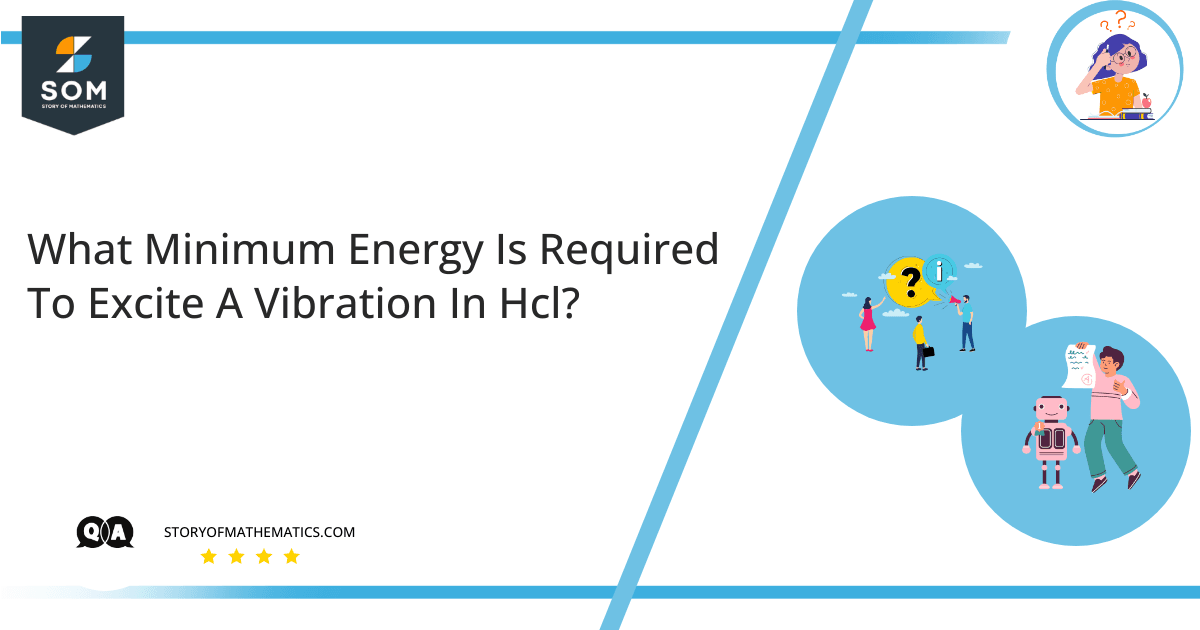
- What wavelength of light is required to excite this vibration? The vibration frequency of HCI is $v= 8.85 \times 10^{13} \space s^{-1}$.
This problem aims to familiarize us with vibrating molecules and the energy they dissipate or absorb from their surroundings. This problem requires the core knowledge of chemistry along with molecules and their movements.
Let’s first look at molecular vibration. Molecules that have only two atoms vibrate by merely forcing closer and then repelling. For instance, the nitrogen $(N_2)$ molecule and oxygen $(O_2)$ molecules vibrate simply. Whereas molecules that contain $3$ or more atoms oscillate in more complicated patterns. For instance, Carbon dioxide $(CO_2)$ molecules have $3$ distinct vibration manners.
Expert Answer
We can define the energy of a vibrating molecule as a quantized mechanism that is much similar to the vibrancy of an electron in the hydrogen $(H_2)$ atom. The mathematical equation to calculate the different energy levels of a vibrating molecule is given as:
\[ E_n = \left( n + \dfrac{1}{2} \right) \space hv\]
Where,
The $n$ is the quantum number with the positive values of $1, 2, 3, \space …$.
The variable $h$ is Planck’s constant and is given as $h = 6.262 \times 10^{-34} \space Js$.
And, $v$ is the vibrating frequency of HCI and is given as $v= 8.85 \times 10^{13} \space s^{-1}$.
The minimum energy required to vibrate the HCI can be calculated by finding the difference between the energies of the two lowest quantum numbers.
So finding the energies at quantum number $n =1, 2$ and subtracting to find the minimum energy required to vibrate the HCI:
\[E_1 = \left(1 + \dfrac{1}{2} \right) hv = \left(1 + \dfrac{1}{2} \right) (6.262 \times 10^{-34}).(8.85 \times 10^{13})\]
\[E_1 = 8.796015 \times 10^{-20}\]
\[E_2 = \left(2 + \dfrac{1}{2} \right) hv = \left(1 + \dfrac{1}{2} \right) (6.262 \times 10^{-34}).(8.85 \times 10^{13})\]
\[E_1 = 1.466 \times 10^{-19}\]
Now finding the difference using this equation:
\[\Delta E = E_2 – E_1\]
\[=1.466 \times 10^{-19} \space – \space 8.796015 \times 10^{-20}\]
$\Delta E$ comes out to be:
\[\Delta E = 5.864 \times 10^{-20} \space J\]
Now find the wavelength of the light that can excite this vibration.
The generic formula for calculating $\Delta E$ is given as:
\[\Delta E = \dfrac{hc}{ \lambda }\]
Rearranging it for the wavelength $\lambda$:
\[\lambda = \dfrac{hc}{\Delta E}\]
Inserting the values and solving to find the $\lambda$:
\[\lambda = \dfrac{ (6.262 \times 10^{-34}).(3.00 \times 10^{8}) }{ 5.864 \times 10^{-20} }\]
$\lambda$ comes out to be:
\[\lambda = 3390 \space nm\]
Numerical Answer
The Minimum energy required to vibrate the HCI is $\Delta E = 5.864 \times 10^{-20} \space J$.
The wavelength of the light that can excite this vibration is $3390 \space nm$.
Example
What wavelength of light is required to excite the vibration of $3.867 \times 10^{-20} \space J$?
Formula is given as:
\[\lambda = \dfrac{hc}{\Delta E}\]
Inserting the values and solving to find the $\lambda$:
\[\lambda=\dfrac{ (6.262 \times 10^{-34}).(3.00 \times 10^{8}) }{ 3.867 \times 10^{-20} }\]
$\lambda$ comes out to be:
\[\lambda=4.8 \space \mu m\]
